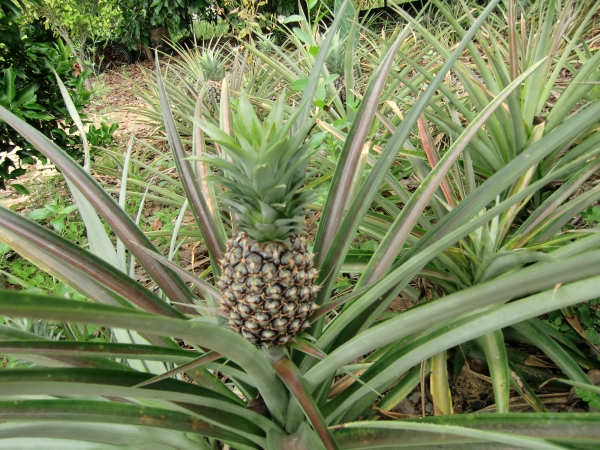

Pineapple
In our yard there is pineapple planted on many places, the plants also are bringing harvests. The pineapple (Ananas comosus) belongs to the family Bromiliaceae. It’s originated from the tropical America and is grown as fruit in the tropical regions worldwide. It forms fleshy multiple fruits, which are used for fresh eating or for conserves or juice.
The pineapple is one terrestical bromelia species, it roots into the ground during most of the other bromelia species are growing epiphytic.
From the vegetation cone of the subterrestrial stem one foot (30 cm) long inflorescence grows. At the peg-shaped inflorescence are over 100 individual flowers sitting in eight spirals. At the upper end are leaf-shaped high leaves which are forming one leaf tuft. The tuft can also be used as cutting as well as the suckers. Seeds are not forming at the cultivars, cultivars are sterile like bananas.
The pineapple fruit is formed by berry fruits of the total inflorescence as well as the inflorescence shaft and the leaf tuft at the top together, is one bound of fruits. The form is cylindric to conic. Size, shape, taste and color are very different according to varieties, the color of the inflorescence reachs from yellowish to brownish, the pulp from whitish to light yellow.
In the fruit inflorescence is the thickened,
fleshy and fiberous inflorescence stalk. To the outside the flesh follows,
formed by the berries and the lower parts of the carrying leaves, which are all
overgrown. The bark consists of the calyx and petals, the uppermost part of the
ovary and the brown, membranous ends of the carrying leaves.
The pineapple fruit is rich in vitamins and minerals as well as in enzymes
and vitamin E. Other ingredients are potassium, magnesium, phosphorus, iron,
copper, manganese, zinc, iodine and carotene. The pineapple has already been cultivated in the
pre-columbian time and in over large parts of South America and in the north
to Mexico widespreaded. It was grown by the Indians as food, medicines and
used for wine production. Christopher Columbus discovered them in 1493 on
his second trip to Guadeloupe.
For a worldwide distribution caused mainly by the Portuguese, the pineapple was brought to St. Helena shortly after 1502, and in 1550 to India. Even before the end of the 16th Century it was in most tropical areas. From approximately 1700, the pineapple also was grown in Europe. Especially in the 18th and 19th Century, the pineapple was grown in England and France in greenhouses. From France the variety 'Smooth Cayenne' was widespreaded into all the world. The limited storability of fruits set trade limited for a long time, even at that time because of the lack of refrigerated ships and airplanes, also there were no cans yet. From the 19th Century the whole plants of the Caribbean were shipped to Europe, as far as prices were falling and the greenhouse cultivation had to go back. The Caribbean has established itself as a supplier for the U.S., while Europe is primarily supplied from the Azores, also in the Canaries was pineapple grown.
The industrial processing and mechanized cultivation/harvest began at the end of the 19th Century in Hawaii, which quickly became the main pineapple grown ascended.
The climatically favorable production areas are located in the tropics between 25° north and south latitude. In South Africa and Australia the pineapple is still grown to 34° south latitude. The optimum temperature is 24° to 30°C, below 20°C the growth is reduced significantly. During the fruit ripening temperatures below 21°C can have to physiological disturbances, which are showing as brown spots in the fruit. Particularly, the climate of Lucianópolis is still suitable for pineapple cultivation.
At least 800 to 900 mm rainfall per year are needed, from 1000 to 1500 mm are ideal.
The soil requirements of pineapple are rather low. Very important is just a good water management, since short periods of moisture severely damaging the plants. The most suitable are sandy clays, the soil in our garden is still optimal.
The cultivation cycle rarely lasts longer than four years. After the plant is the time to first harvest in the equatorial regions from 14 to 16 months in colder areas 18 to 20 months. The second and third harvest takes place at shorter intervals, but declines in yields as compared to the first harvest continually. The second harvest in cooler areas, providing 60 to 100 percent of the first harvest, in hot-humid areas only 40 percent.

Pineapple
with fruit in our garden in December 2009.
Updated by Joachim Jaeck on October 14th, 2013